|
|
|
Roman Pantheon
Friday, May 6 2011
location: North Atlantic Ocean
Flying with the winds but against the Earth's spin sped the sun and quickened the night. The first light of day coincided with our arrival in French airspace over Brest (in its northwest corner). There wasn't much to see until near the southern Alps, which lie on or close to whatever natural feature forms the boundary between Italy and France. At this time of year, some of the peaks and even whole ridgelines are still white with snow. Out over the Mediterranean, we flew directly over Corsica, which was bigger and more mountainous than I expected. Some of its peaks were also snow-capped. Further to the southeast, as we approached the Italian peninsula, I had spectacular views of a number of small islands, one of which looked as if it was partly encrusted with rust-colored barnacles. These were the terracotta roofs of houses arranged along cramped organic (non-rectilinear) street networks.
The Rome airport is near the Mediterranean beach. As we flew in low, it looked like a paradise down there, with dense, tidy communities separated by large tracts of open space, much of it forested. Had this been a similar place in the United States, the open space would have all been eaten up by suburban development full of wide curving streets, cul du sacs, and Lord only knows how much ChemLawn.
The Rome airport itself had a vaguely third world griminess to it, though in the sparkling cloud-free light of the Mediterranean morning it just added to the charm.
Italian immigration and customs were perfunctory at best. Glancing at the covers of our US passports, the immigration guy waved us through. It wouldn't take a very accurate counterfeit American passport to gain access to Italy, though this trick might only be possible when pulled off by Caucasians. There's probably a concerted effort by Italian authorities to turn back people likely to attempt a career selling roses in the street. More on that in a bit.
While still in the airport, we converted something like eight hundred US dollars into a distressingly small number of euros. (A euro was, at the time, worth about $1.60 [and that was before the United States had taken major strides towards defaulting on its good faith and credit].)
After we emerged on the streets of Rome, we initially tried to find a bus to take us to the general location of the apartment Gretchen had arranged for us. But we couldn't find the bus station, so we just started walking westward. We were supposed to call the guy whose apartment we were renting, but we didn't have a working cellphone, and we couldn't figure out the stainless-steel card-only pay phones ubiquitous on the Roman streets. Eventually Gretchen made the necessary call from an internet café (which rented out normal phones by the minute). At some point along the way, we stopped for our first shots of espresso, which we drank while standing at a counter. (It costs more to drink it at a table.)
Somehow Gretchen had found us an affordable apartment in the heart of the most beautiful part of historic Rome, the "Ponte Riono" near the Piazza Navona and within easy walking distance of the Pantheon. Our place was still being cleaned when we arrived and the woman working there didn't know English. No problem; as always, Gretchen had come with a working knowledge of basic Italian, though she kept accidentally using Spanish words (such as "pero" instead of "ma" for "but"). But she's fearless when it comes to speaking to strangers, even if it requires pantomime. While Gretchen handles communication, I usually just stand there with a smile on my face. I'm the quiet one, something even Jon Stewart noted about us that one time we were in his audience.
As for our apartment, it had been built as a glass-roofed shed on the side of a tall masonry building in a small private courtyard. The masonry wall blocked out the sun and provided a nice rustic surface along the back of the apartment's three rooms, while the frosted glass ceiling let in plenty of indirect light from high in the north sky, though, being a roof, it was also a bit cluttered with leaves and random debris (and the occasional strolling pigeon).
We had twenty minutes until the apartment's owner was to show up, so we dropped our bags and went out to wander the neighborhood. This mostly meant the Piazza Navona, a long narrow plaza centered around a big cheeseball obelisk-topped fountain made by Bernini honoring four important rivers known to 17th Century Romans: the Ganges, the Nile, the Danube, and the Rio de la Plata in South America (a shit you not on that last one).
The streets in this part of Rome are narrow and paved with cubic cobblestones worn smooth by years of use. Despite their narrowness and the abundance of pedestrians, vehicles are also allowed to drive on them (though usually only one way). Vehicles, particularly scooters and motorcycles, often drive quickly down these streets until encountering a pocket of pedestrians or other obstruction. I'd heard the stories about maniacal Italian drivers and been worried about crossing streets, but in Rome at least drivers seem more deferential to pedestrians than they had in Paris. If you're in a striped crosswalk across a major (asphalt-paved) street, you can count on vehicles stopping to let you cross. By the way, I have never seen so many women on motorcycles as one sees in Rome. (It makes the United States seem backward and gender-hobbled by contrast.)
Eventually we connected with the owner of our apartment, paid him his 360 euros for however many nights we'd be staying, and hit the streets of Rome. Gretchen had slept reasonably well on the plane, but both of us were pretty jetlagged. Still, Gretchen likes to push-push-push once we land in a foreign city, and Rome at this time of year is more compelling than Paris had been when we'd been there in January of 2002.
First we walked over to the Pantheon, a huge cylindrical and somewhat crumbled brick mass that towers over the conventional buildings crowding in on three sides. Most of the Pantheon sits at the bottom of a 15 foot well: Rome around it has risen at least that much in the 1900 years since it was built. In front of the Pantheon there is a modest piazza where efforts have been made to keep soil from accumulating. Still, what had once been a flight of steps up to the portico has been drowned beneath the rising land, making the portico floor even with the piazza. As with most Roman piazzas (at least in this neighborhood), the one in front of the Pantheon features an elaborate sculptural fountain and an obelisk that may or may not have been pillaged from ancient Egypt. On the far fringes of the piazza, a number of restaurants have arranged for outdoor seating.
Inside the Pantheon, I was somewhat dismayed to see that it had received a light makeover as some sort of Catholic church, as though maybe there had been a church shortage in Rome. (This makeover is the only reason the building wasn't completely cannibalized.) A crucifix with a bloody Jesus had been moved into the part of the rotunda opposite the door, and, with its gilded ordinariness in the presence of such serenity and ancientness, it resembled a plastic yard flamingo. But otherwise, the interior of the Pantheon was a marvel, mostly because of the strange combination of its incredible age and its timeless gravitas. The oculus, a 30 foot hole in the dome, easily filled the space with sufficient light. And around that hole was an abstract pattern pressed into the ancient concrete that could easily have been an decorative motiff in a contemporary concrete structure (though one that has been duplicated in surprisingly few places). It was impossible to tell from the marble floor below, but the oculus is open and admits precipation. Supposedly there are drains in the floor beneath it, but when we arrived, that part of the Pantheon was crowded with wide-eyed tourists much like ourselves. In the alcoves around the inside's perimeter where statues of the gods used to be, there are now various saints and martyrs, as well as the tombs of a few secular heroes such as the painter Raphæl and a 19th Century Italian king.
Gretchen and I walked around the entire outside of the Pantheon, noting the blind arches and other exposed brickwork, as well as the traces of marble and various cantilevered bits hinting at original surface treatments that had mostly been scavenged for other buildings. Most of the outside of the Pantheon is ancient brick, a bit of which has crumbled or dissolved away to the point of looking more natural than manmade. There are even a number of small trees growing on its "summit." Still, the walls are massive and it's a good ten to twenty feet separating the inside from the outside. It seems it's possible to have a tidy marble-clad interior within something that increasingly resembles a geological formation. Some day it might be something of a massive geode.
We ended up walking all the way to the north gates of old Rome, Piazaa del Popolo, where one can, with a wide enough lens angle, take a photograph with three point perspective. From there we stopped by the Trevi Fountain, the most spectacular in Rome, where a crowd of people had gathered to see them turn on. It was something of a natural water fall combined with a pond, with pagan figurines set in naturalistic rough-cut travertine in the foundation of a large marble building. I soaked my sore flip-flop-clad feet in the pond until someone warned me that I could get a 500 euro fine.
When we finally had our first Roman meal, it was in outdoor seating near the Spanish Steps (the widest flight of stairs in all of Europe). We both ordered pasta with tomato sauce (pomodoro), though I had mine done arabica, that is, with a little hot spice thrown in. We also got glasses of some sort of wine.
After a long nap back at our apartment, we went out a second time, this time for dinner in our lovely neighborhood at a place called Ristorante Bar Del Fico. It being Friday night, people were out and about. The cafés and pizzerias spilled out onto the cobblestones, creating a gradual transition from people indoors to people driving in vehicles. People were mostly drinking wine. And those who weren't eating animals were mostly eating pizza. Pizza in Italy is made with a thin crust and a little larger than a legal pad, rectangular with rounded corners. You never order sizes of pizza; you order a pizza and that one size is what you get. And you have to slice it yourself. But I'm getting ahead of myself. Tonight Gretchen and I ordered pasta again, and learned conclusively that, at least in the touristy parts of Rome, it's important to, as a vegan, make sure you tell the waitress "senza formaggio." This hadn't been a problem at our lunch place, but our dinner tonight was — perhaps not drenched — but richly covered with flakes of melted cheese (none of which had been mentioned in the menu). Despite the implications for when we arrive at the simulated-pearl gates of Vegan Heaven, we ate the pasta anyway. We also ordered a bottle of some sort of wine. It was a great evening for people watching. At some point a table at the restaurant across the street burst into song. And then a group of teenagers came by and hung out in the street for awhile, doing what teenagers do on Friday nights. It seemed just a little too easy to be a teenager in this neighborhood.
Later, we were accosted multiple times by swarthy men attempting to sell us roses. If you were assertive, you could wave them off, but the couple next to us was early in their relationship, a bit of purchase one of the swarthy men attempted to exploit. But then Gretchen interceded on their behalf and shooed the rose salesman away. On several occasions, other swarthy men would appear and try to sell stuffed animals whose ears could be made to move animatronically. The roses made a certain amount of sense in a city that would lend its name to the very concept of nonsuperficial love, but I couldn't imagine there being much of market for animatronic dogs. [Later we would do some research and learn that the men who try to sell things to tourists on the streets of Rome mostly come from such places as Sri Lanka and Bangladesh.]
After dinner, we returned yet again to the Piazza Navona, where various mediocre musical acts busqued and swarthy men attempted to sell tiny pistol-launched frizbees embedded with bright LEDs. They also had flashlights that projected precise abstract geometric shapes in green via an inexpensive laser-based technology. If I were to buy such a flashlight and use it, people in Rome would merely think me to be an unusually light-skinned Bangladeshi.

The Pantheon's oculus.
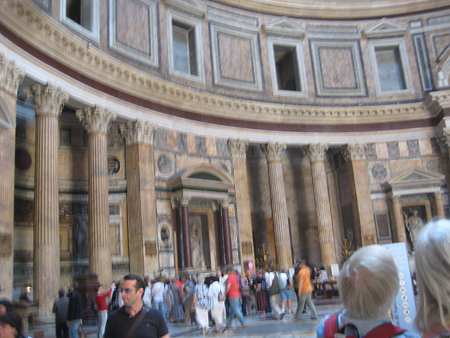
Inside the Pantheon.
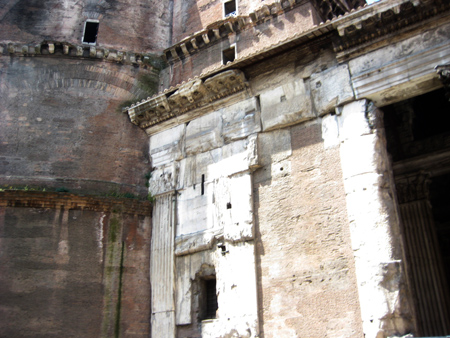
Remnants of the Pantheon's marble exterior cladding.
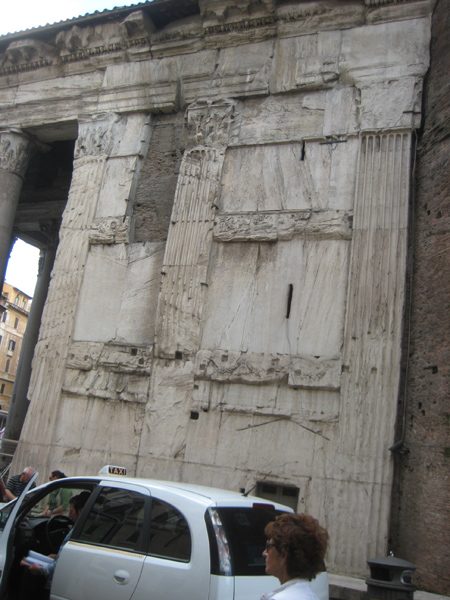
More cladding remnants.
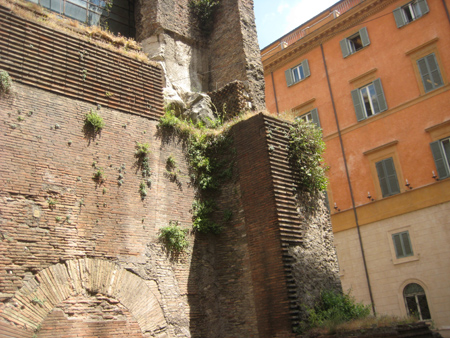
Crumbling Pantheon exterior with vegetation.

Blind arches and brickwork of the Pantheon.
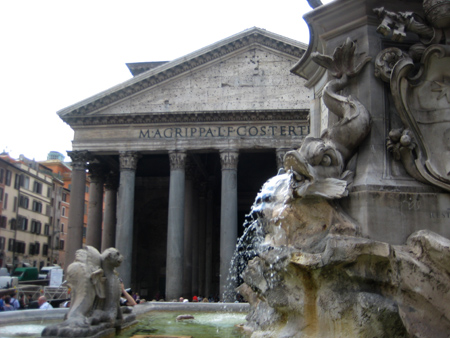
Pantheon portico with fountain. Marcus Aggripa didn't actually build this thing.
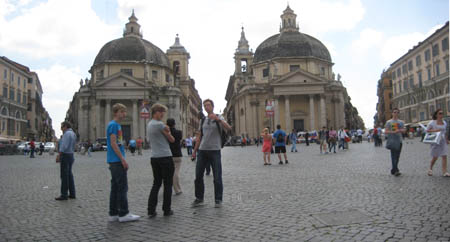
Three point perspective from the Piazza del Popoli. Click to enlarge.
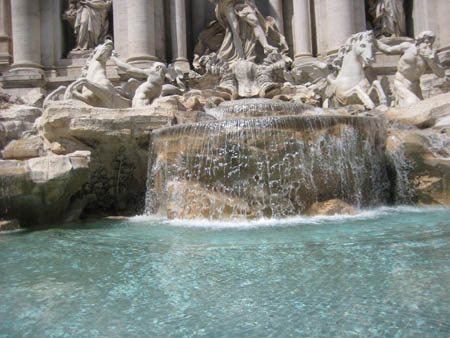
Trevi Fountain.
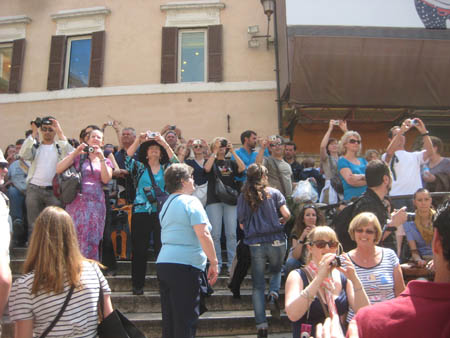
Tourists loving the Trevi Fountain.
For linking purposes this article's URL is:
http://asecular.com/blog.php?110506 feedback
previous | next |









